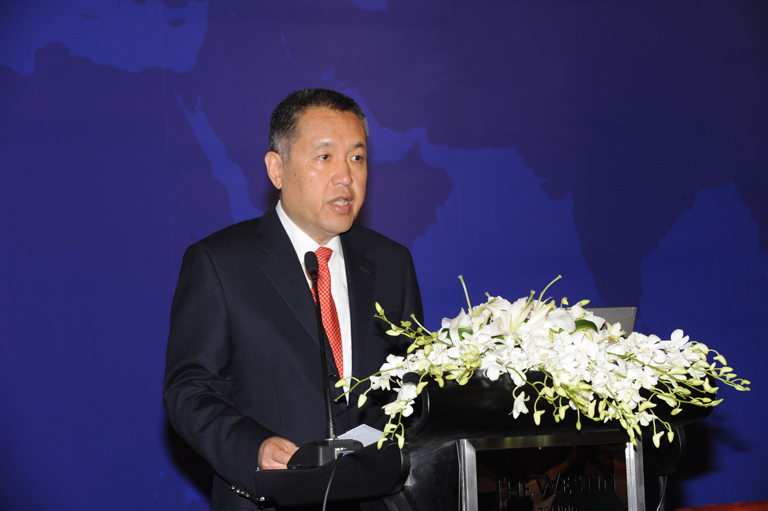
China’s New Trademark Law
By Mr. ZHANG Mao, Minister, State Administration for Industry and Commerce (SAIC), People’s Republic of China
Establishing the conditions for innovation and creativity to thrive and improving China’s intellectual property (IP) system are top priorities for the Chinese Government in its process of reform and opening up. The newly amended Trademark Law of the People’s Republic of China, which took effect on May 1, 2014, is the latest major step in enhancing the country’s IP system. The new trademark law streamlines trademark registration procedures and strengthens the legal protection of trademarks in China in line with international standards. It also promises to generate significant economic and social benefits for the country and to support the growth of the global economy and trade.
Since the adoption of its policy of reform and opening up, the Chinese Government has been paying increasing attention to the importance and role that IP plays in socioeconomic development and consistently working to improve the country’s IP system. IP is a strategic national resource for the development of innovation and a core element in determining a country’s ability to compete in international markets.

Since its promulgation in 1982, there have been two amendments to the trademark law - in 1993 and 2001 – in line with the evolution of China’s market economy and the internationalization of economic growth. This ongoing strengthening of the legal framework for protecting trademarks in China is aimed at protecting the legitimate rights and interests of trademark owners and consumers and to maintaining competitive and fair market conditions.
The promulgation and implementation in 2008 of China’s national IP strategy provided a good policy and legal basis for the further development of the country’s trademark system.
A trademark powerhouse
Over the years, China has seen marked improvement in the registration, use, protection, and management of trademarks, which are now playing an increasingly important role in promoting business growth and economic development. But in recent years, China has emerged as a true trademark power. The country’s trademark office processes the largest number of trademark applications in the world. By the end of 2013, China had recorded a cumulative total of 13.24 million trademark applications and 8.65 million registrations, of which 7.24 million remain in force.
In 2013, China was the seventh largest user of the Madrid System for the International Registration of Marks with a record 2,359 applications (one mark covering multiple classes) filed by Chinese applicants (infographic ![]() ). This represented an increase of 8.3 percent over the previous year, bringing the cumulative total number of registrations to 17,000. In the same year, 20,275 international trademark applications (covering multiple classes) designating China were received by the Chinese Trademark Office bringing the cumulative total number of applications designating China to 196,000. For the eighth year running, China was the most designated country member of the Madrid System.
). This represented an increase of 8.3 percent over the previous year, bringing the cumulative total number of registrations to 17,000. In the same year, 20,275 international trademark applications (covering multiple classes) designating China were received by the Chinese Trademark Office bringing the cumulative total number of applications designating China to 196,000. For the eighth year running, China was the most designated country member of the Madrid System.

Against a backdrop of increasing economic globalization and the internationalization of China’s market economy, it became clear that the trademark law as amended in 2001 required updating to keep pace with the country’s on-going comprehensive process of reform and opening up. The new third amendment of the trademark law adopted in May 2014, introduces significant improvements to China’s trademark system. Its overriding objectives are to:
- streamline procedures associated with acquiring trademark rights;
- ensure a fair market for trademark holders; and
- clamp down on trademark infringements with a view to protecting the interests of consumers, producers and other business operators.
In order to improve the management and administration of China’s trademark system, the amendments to the new law include, but are not limited to, measures that simplify trademark application and examination procedures, providing applicants with more user-friendly and efficient trademark registration services. Other amendments seek to improve the trademark opposition system, set time limits for the review and adjudication of trademarks; allow for sound marks to be registered; enable electronic filing of applications, and establish procedures for the efficient processing of “multi-class applications” and the communication of review opinions.
In terms of the registration, use and representation of trademarks to ensure fair competition and market order, the law clarifies the system for protecting well-known marks, and adds provisions on the principles of honesty and integrity. It explicitly prohibits trademark hijacking, reinforces guidance and protection of trademark use, and tightens the regulation of trademark agents.
With a view to strengthening the legitimate rights and interests of trademark holders, the law identifies additional types of legally liable trademark infringement, provides for heavier and more stringent penalties and punitive damages where infringement occurs and reduces the burden of proof on trademark holders.
By providing more user-friendly and efficient government services for trademark applicants, and by establishing a fairer and more just legal environment, the Government is seeking to encourage and support independent innovation, help make China’s business community more competitive and make China, the world’s largest market, a more attractive place for foreign companies to do business.
The new law also sets higher standards for the State Administration for Industry and Commerce (SAIC), requiring us to provide higher quality public services in the interests of safeguarding social equity and justice. As such, it supports the Government’s drive to encourage innovation-driven development and accelerate the transformation of China’s economic growth pattern.
Since China joined WIPO in 1980, and in particular, since 2009 when SAIC signed a cooperation agreement with WIPO, we have placed great emphasis on raising public awareness and providing training on the advantages of acquiring and protecting trademark rights both at home and abroad. A particular focus has been to highlight the benefits of using the Madrid System to register trademarks internationally. Thanks to these efforts, trademark awareness among the business community has been greatly enhanced.
The expanding trademark portfolios of Chinese firms and the rising number of international applications filed under the Madrid System, in particular, demonstrate broad recognition among Chinese entrepreneurs of the advantages of protecting their trademarks internationally. The success of companies such as Huawai and Gree Electric Appliances Inc. demonstrate what can be achieved when an effective branding strategy, underpinned by a robust portfolio of national and international trademark rights, is implemented. Both of these companies are users of the Madrid System and each has been able to build its international business and become more competitive in the global marketplace through strategic use of their IP, including their brands.
In implementing the new trademark law, SAIC, the government agency responsible for administering China’s trademark system, is working to ensure the timely, efficient and effective delivery of high-quality trademark services for both foreign and domestic businesses. To this end, efforts are being made to:
- publicize and implement the new trademark law effectively and to accelerate the revision and promulgation of supplementary rules and regulations;
- strengthen trademark regulation and law enforcement to ensure fair competition and market order;
- improve the implementation of the national trademark strategy to facilitate the effective use and protection of trademarks for socioeconomic development; and
- constantly improve the Administration’s competence in trademark examination.
As the Chinese market becomes more open and dynamic, the strategic use of trademarks by businesses operating in China and beyond will become ever more important. We trust that as the legal framework for trademarks continues to evolve and improve, increasing numbers of foreign enterprises will start and develop their business in China. This will enable them to participate in China’s economic development, share in the fruits of the country’s economic growth and the on-going and deepening process of reform.
The WIPO Magazine is intended to help broaden public understanding of intellectual property and of WIPO’s work, and is not an official document of WIPO. The designations employed and the presentation of material throughout this publication do not imply the expression of any opinion whatsoever on the part of WIPO concerning the legal status of any country, territory or area or of its authorities, or concerning the delimitation of its frontiers or boundaries. This publication is not intended to reflect the views of the Member States or the WIPO Secretariat. The mention of specific companies or products of manufacturers does not imply that they are endorsed or recommended by WIPO in preference to others of a similar nature that are not mentioned.